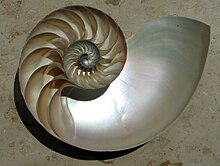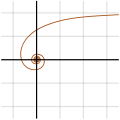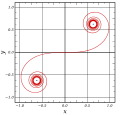A | B | C | D | E | F | G | H | CH | I | J | K | L | M | N | O | P | Q | R | S | T | U | V | W | X | Y | Z | 0 | 1 | 2 | 3 | 4 | 5 | 6 | 7 | 8 | 9
In mathematics, a spiral is a curve which emanates from a point, moving farther away as it revolves around the point.[1][2][3][4]
Helices
Two major definitions of "spiral" in the American Heritage Dictionary are:[5]
- a curve on a plane that winds around a fixed center point at a continuously increasing or decreasing distance from the point.
- a three-dimensional curve that turns around an axis at a constant or continuously varying distance while moving parallel to the axis; a helix.
The first definition describes a planar curve, that extends in both of the perpendicular directions within its plane; the groove on one side of a record closely approximates a plane spiral (and it is by the finite width and depth of the groove, but not by the wider spacing between than within tracks, that it falls short of being a perfect example); note that successive loops differ in diameter. In another example, the "center lines" of the arms of a spiral galaxy trace logarithmic spirals.
The second definition includes two kinds of 3-dimensional relatives of spirals:
- a conical or volute spring (including the spring used to hold and make contact with the negative terminals of AA or AAA batteries in a battery box), and the vortex that is created when water is draining in a sink is often described as a spiral, or as a conical helix.
- quite explicitly, definition 2 also includes a cylindrical coil spring and a strand of DNA, both of which are quite helical, so that "helix" is a more useful description than "spiral" for each of them; in general, "spiral" is seldom applied if successive "loops" of a curve have the same diameter.[5]
In the side picture, the black curve at the bottom is an Archimedean spiral, while the green curve is a helix. The curve shown in red is a conic helix.
Two-dimensional
A two-dimensional, or plane, spiral may be described most easily using polar coordinates, where the radius is a monotonic continuous function of angle :
The circle would be regarded as a degenerate case (the function not being strictly monotonic, but rather constant).
In --coordinates the curve has the parametric representation:
Examples
Some of the most important sorts of two-dimensional spirals include:
- The Archimedean spiral:
- The hyperbolic spiral:
- Fermat's spiral:
- The lituus:
- The logarithmic spiral:
- The Cornu spiral or clothoid
- The Fibonacci spiral and golden spiral
- The Spiral of Theodorus: an approximation of the Archimedean spiral composed of contiguous right triangles
- The involute of a circle, used twice on each tooth of almost every modern gear
An Archimedean spiral is, for example, generated while coiling a carpet.[6]
A hyperbolic spiral appears as image of a helix with a special central projection (see diagram). A hyperbolic spiral is some times called reciproke spiral, because it is the image of an Archimedean spiral with a circle-inversion (see below).[7]
The name logarithmic spiral is due to the equation . Approximations of this are found in nature.
Spirals which do not fit into this scheme of the first 5 examples:
A Cornu spiral has two asymptotic points.
The spiral of Theodorus is a polygon.
The Fibonacci Spiral consists of a sequence of circle arcs.
The involute of a circle looks like an Archimedean, but is not: see Involute#Examples.
Geometric properties
The following considerations are dealing with spirals, which can be described by a polar equation , especially for the cases (Archimedean, hyperbolic, Fermat's, lituus spirals) and the logarithmic spiral .
- Polar slope angle
The angle between the spiral tangent and the corresponding polar circle (see diagram) is called angle of the polar slope and the polar slope.
From vector calculus in polar coordinates one gets the formula
Hence the slope of the spiral is
In case of an Archimedean spiral () the polar slope is
The logarithmic spiral is a special case, because of constant !
- curvature
The curvature of a curve with polar equation is
For a spiral with one gets
In case of (Archimedean spiral)
.
Only for the spiral has an inflection point.
The curvature of a logarithmic spiral is
- Sector area
The area of a sector of a curve (see diagram) with polar equation is
For a spiral with equation one gets
The formula for a logarithmic spiral is
- Arc length
The length of an arc of a curve with polar equation is
Text je dostupný za podmienok Creative
Commons Attribution/Share-Alike License 3.0 Unported; prípadne za ďalších
podmienok.
Podrobnejšie informácie nájdete na stránke Podmienky
použitia.

















































